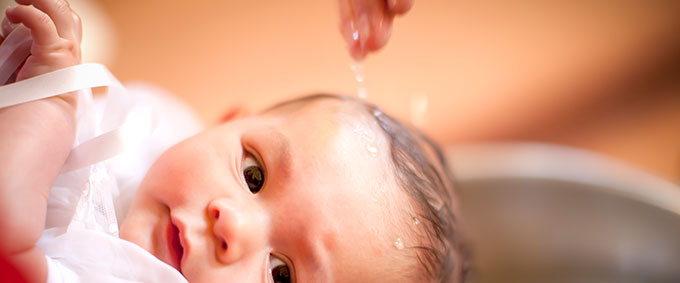The Sacrament of Baptism

We become members of Christ and the Church through the Sacraments of Initiation: Baptism, Confirmation, and the Eucharist.
The Old Testament has many images of water that help us understand Baptism. Each year during the Easter Vigil, the water that will be used in baptism is blessed. The prayers of blessing call these images to mind. At the time of Creation, the Spirit breathed upon the waters (Genesis 1:2). During the great Exodus the waters of the Red Sea parted, allowing the people of Israel to cross from slavery to freedom (Exodus 14: 21 – 31). Later, in the New Testament, John the Baptist administered a baptism of repentance to Jesus in the waters of the River Jordan (Mark 1: 1 – 11).
Knowing that Baptism is necessary for salvation, parents have their babies baptized not long after they are born. Baptism signifies the baby’s entrance into the Church. The community of believers and the parents make a commitment to care for and teach this child as he or she is raised in the Catholic faith.
In the early Church infant baptism was not the usual way that people became members of God’s family. Initiation into the Church was primarily done for adults. They had to enter into a long period of learning and praying with the Christian community. Adults seeking to enter the Church today normally enter into the process of the Rite of Christian Initiation of Adults as catechumens. During this process they learn what God has done through Jesus, the teachings of the Church, and how they may respond in faith to God’s call.
In the celebration of Baptism, a person is immersed in water. He or she goes all the way into the water and then comes out. This action is a symbol of dying to sin and rising to new life in Christ. Sometimes water is poured over a person’s head. The celebrant proclaims” “I baptize you in the name of the Father, and of the Son, and of the Holy Spirit.”
The person being baptized is anointed with two oils; the oil of catechumens is put on the chest, and chrism is put on the top of the head. Oil is a symbol of strength and healing.
A candle is lit during the celebration. This shows that the person baptized is asked to keep the flame of faith alive in his or her heart.
Through Baptism a person receives forgiveness of original sin as well as personal sins. The newly baptized person receives sanctifying grace and is sealed with a permanent spiritual mark. This is why Baptism can be celebrated only once.
St. Paul the Apostle wrote about the change that takes place in a baptized person in Romans 6: 3–4. Paul explained that in Baptism Christians are united with the death of Jesus – they are in a sense buried with him. Jesus Christ has been raised from the dead by the glory of the Father. United with Christ believers also rise from the dead to live in newness of life.

